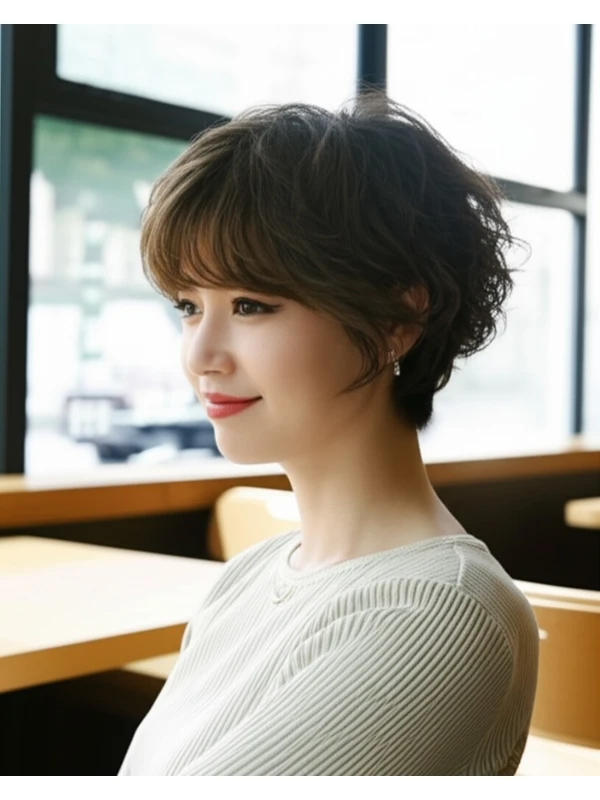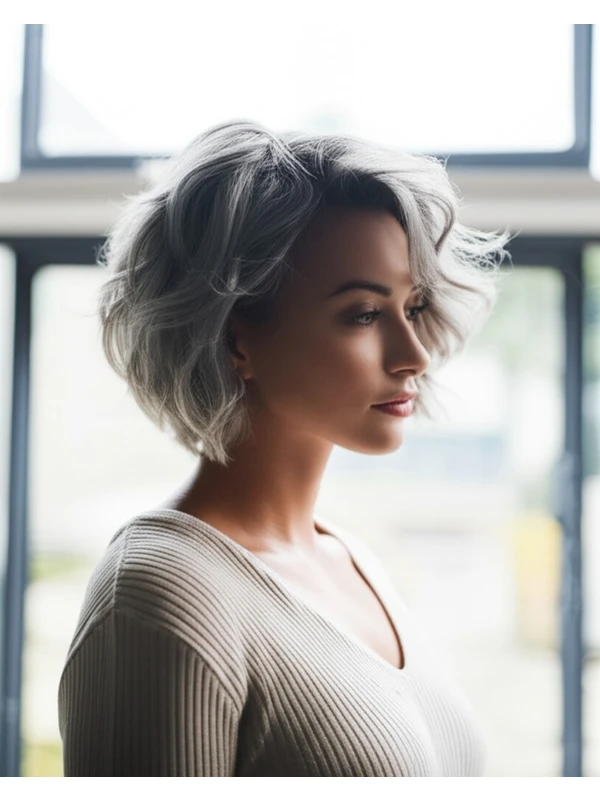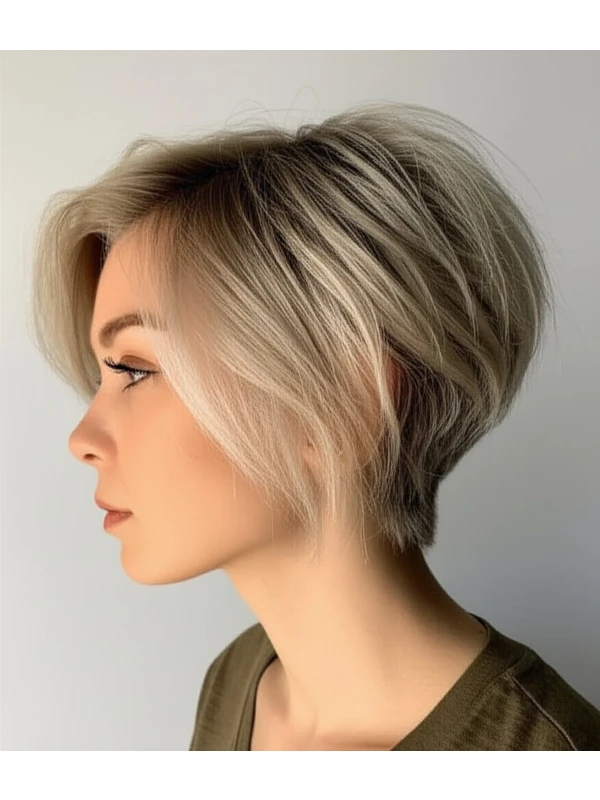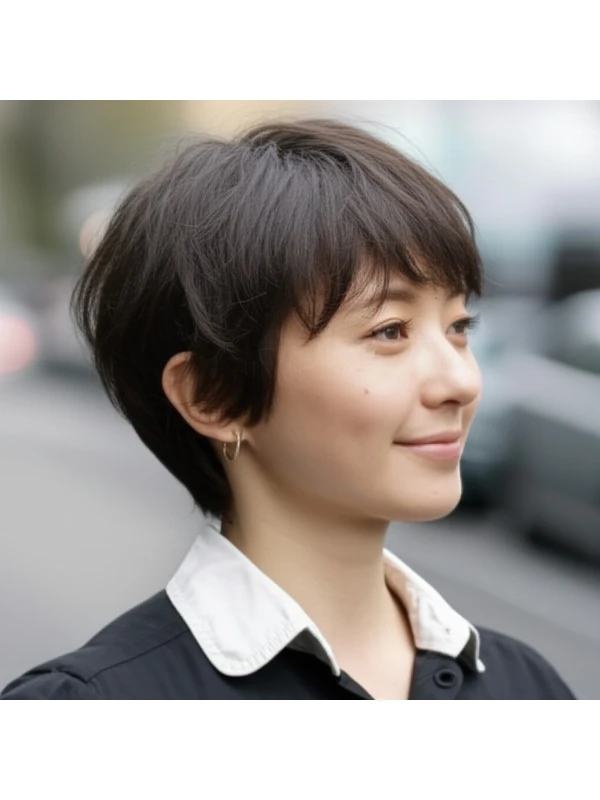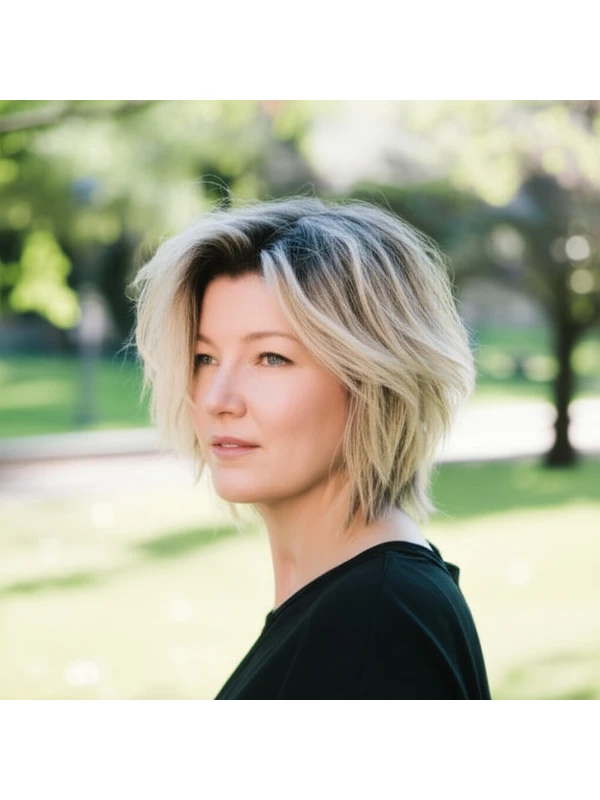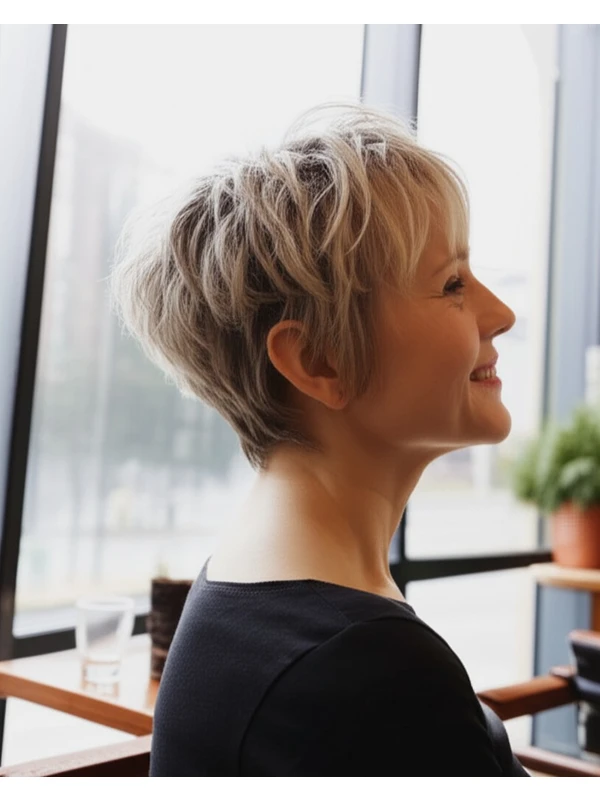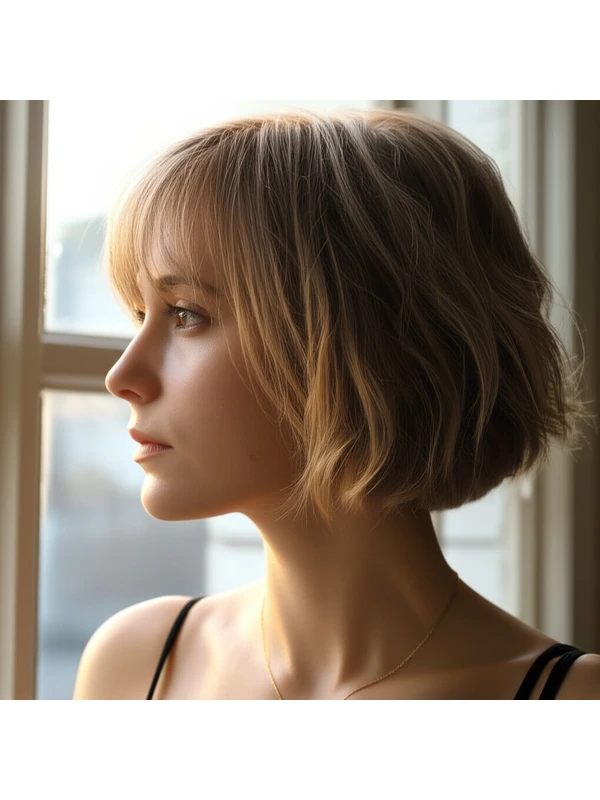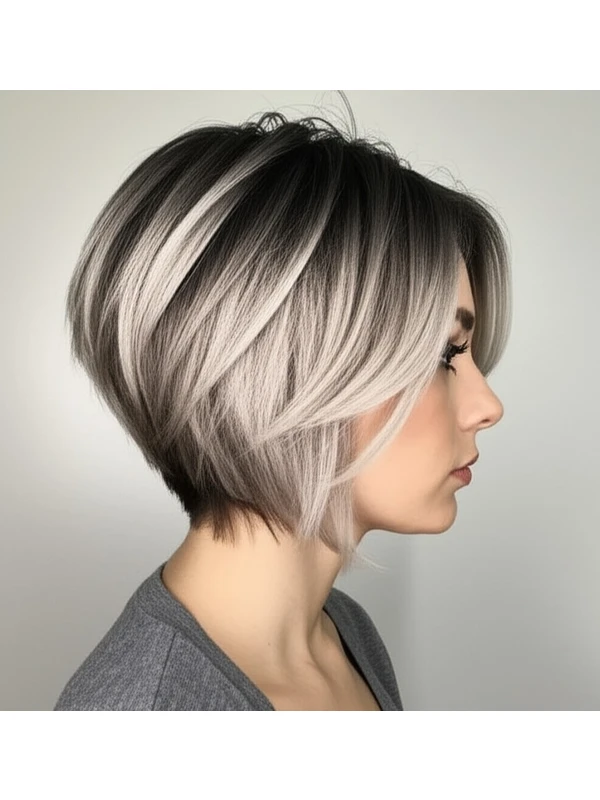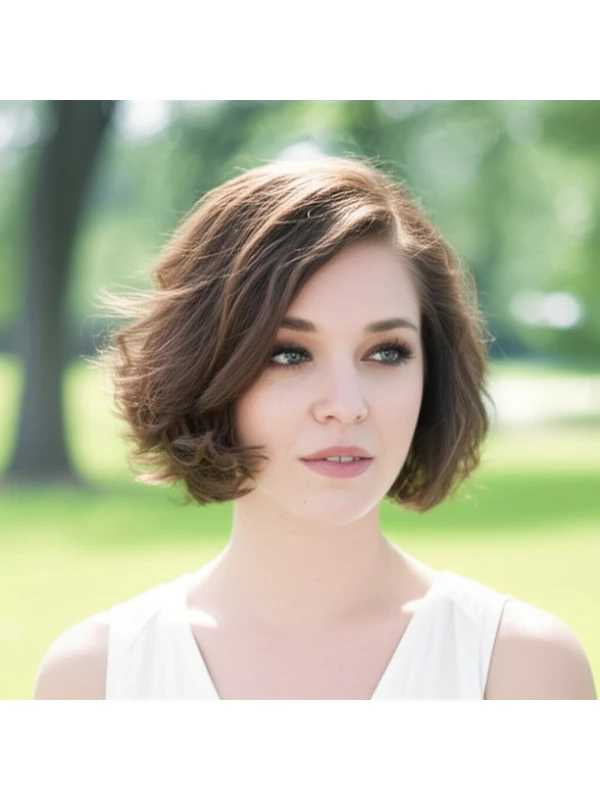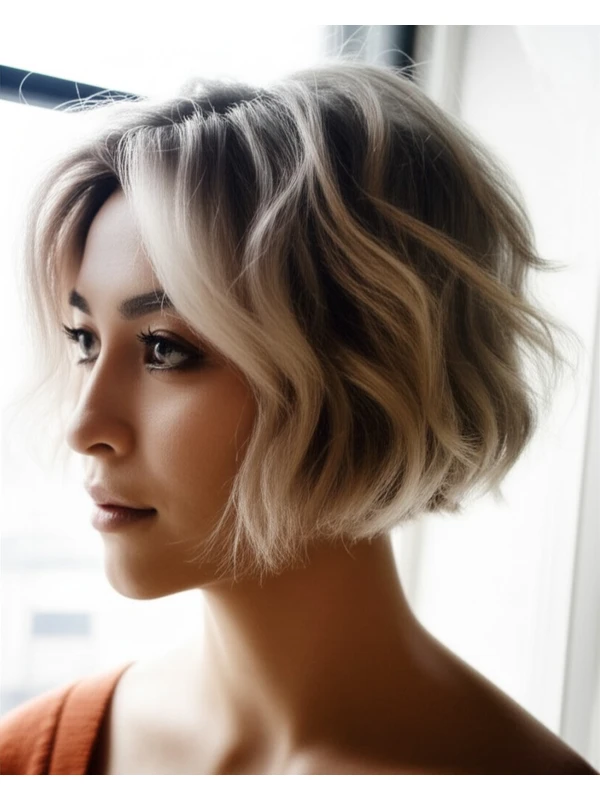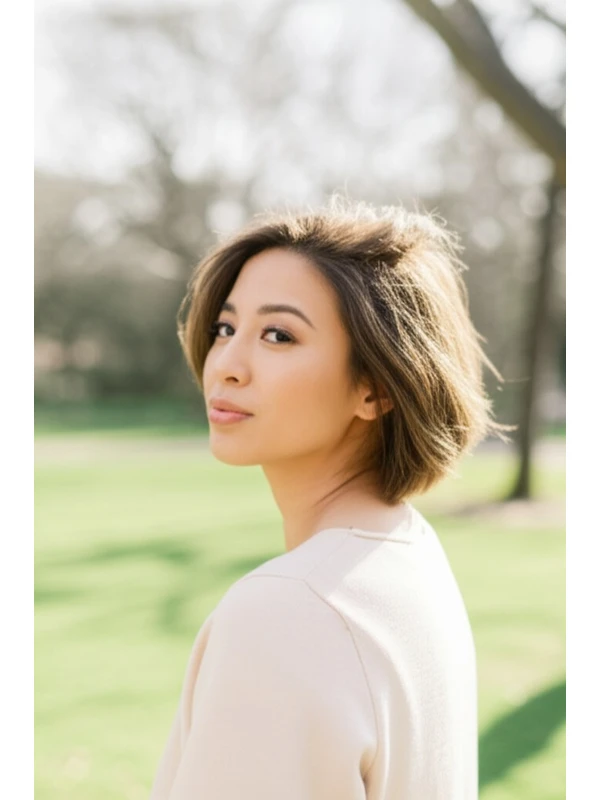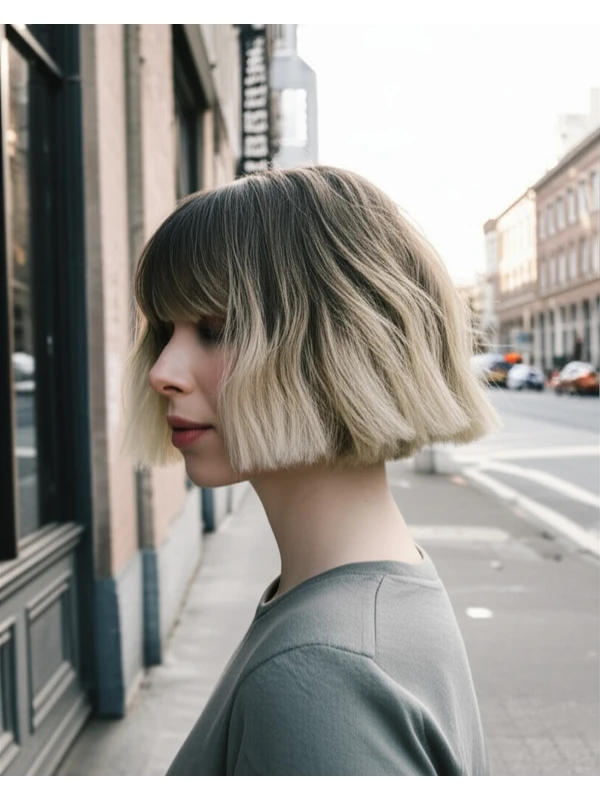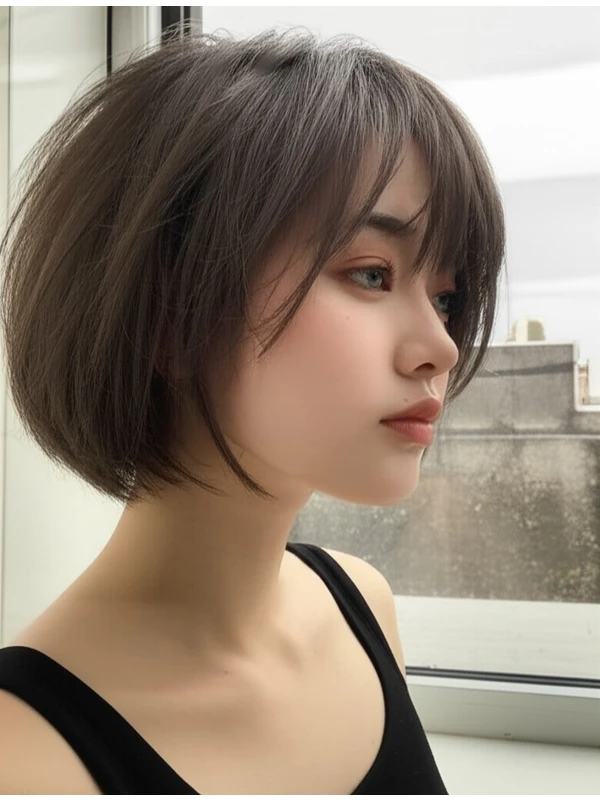#The Wolf Bob: A Guide to This Edgy & Effortless Style
The wolf bob is having a moment! It's a cut that blends the cool confidence of a shag with the chic simplicity of a bob, offering an edgy yet wearable look for many. Here’s everything you need to know about embracing this trend.
#1) Background & Definition: What Is A Wolf Bob?
The wolf bob isn't just one thing – it’s more like a family of styles sharing core DNA. Think of it as a modern, textured bob with layers that create movement and volume. It draws inspiration from the classic shag haircut, but keeps the overall length shorter and cleaner than a full-on shag.
- Cut Geometry: The wolf bob typically features a blunt or slightly layered front section that gradually blends into longer, face-framing layers around the sides and back. The nape (back of your neck) is usually kept relatively short for a more defined shape.
- Key Features: Texture, volume at the crown, face-framing layers, often with a disconnected feel. It's meant to look intentionally undone – effortlessly cool.
- Length Ranges: Generally falls between chin length and just below the shoulders (around 8–16 inches). Shorter wolf bobs are bolder; longer versions offer more versatility for styling.
- Alternative Names: Shag Bob, Textured Bob, Modern Wolf Cut, Layered Bob with Texture.
#2) Face Shape Fit: Finding Your Perfect Angle
The beauty of the wolf bob is its adaptability! However, some tweaks can maximize its impact based on your face shape.
- Oval Faces: Lucky you! Almost any length and variation of the wolf bob will look fantastic. A slightly longer version (below the chin) emphasizes elegance.
- Fringe Options: Curtain bangs or a wispy fringe soften the features further.
- Round Faces: The key is to add angles. Avoid overly blunt cuts that accentuate roundness. Opt for a more angled wolf bob with face-framing layers starting around your cheekbones. Slightly longer lengths (mid-neck) are often most flattering.
- Fringe Options: Side-swept bangs or long, soft curtain bangs can create the illusion of length and slim the face. Avoid blunt, straight-across fringes.
- Square Faces: Soften those angles! The wolf bob’s layers will help to diffuse a strong jawline. A slightly longer version with more layering around the cheekbones is ideal.
- Fringe Options: Curtain bangs that blend seamlessly into the layers are gorgeous, softening the edges of a square face.
- Heart Faces: Balance your wider forehead and narrower chin by choosing a wolf bob with volume at the jawline. A slightly shorter length can also help create more balance.
- Fringe Options: A wispy fringe or soft curtain bangs will draw attention away from the forehead, creating harmony.
- Diamond Faces: Highlight your cheekbones! The layers of a wolf bob naturally accentuate this feature. Medium to longer lengths work well.
- Fringe Options: A textured, piece-y fringe can enhance the diamond shape and add softness around the eyes.
- Oblong/Long Faces: Add width with strategic layering and volume at the sides. Avoid very long wolf bobs that will only elongate your face further. A shorter bob is generally more flattering.
- Fringe Options: A blunt or slightly textured fringe can visually shorten a longer face.
#3) Body Proportions & Height Guidance
Consider your overall proportions when choosing the length and volume of your wolf bob:
- Petite (under 5’4”): Shorter to medium lengths work best, as longer styles can overwhelm smaller frames. Focus on creating lift at the crown for added height.
- Average (5’4”-5'8"): You have a wider range of options! Experiment with different lengths and layering techniques.
- Tall (over 5’8”): Longer wolf bobs that skim your shoulders can be very chic, but ensure there’s enough texture to avoid looking too heavy.
- Narrow Shoulders: Volume at the crown and layered face-framing will broaden your shoulder line visually.
- Broad Shoulders: Avoid excessive volume on top; a more streamlined wolf bob with subtle layering is best.
- Short Neck: Shorter lengths (chin length or slightly above) are generally more flattering, preventing neck shortening. A side part can also help elongate the neck.
- Long Neck: Longer versions of the wolf bob work well to visually shorten the neck and add balance.
#4) Works Best With Hair Types & Densities
The wolf bob's versatility shines here! However, some adjustments are needed based on your hair type:
- Straight Hair: Embraces the cut beautifully! Focus on adding texture with styling products.
- Wavy Hair: The layers will enhance natural waves and create more definition. Be mindful of frizz – a smoothing serum can be helpful.
- Curly/Coily Hair: This is where shrinkage comes into play! A wolf bob looks amazing, but you’ll need to factor in your hair's curl pattern and density when determining the length. A stylist experienced with textured hair is essential.
- Shrinkage Note: Type 3 (curly) and Type 4 (coily) hair can shrink significantly after drying—what looks like a shoulder-length cut wet may end up being much shorter dry. Communicate this to your stylist!
- Fine Hair: Layers add volume, but be careful not to overdo it – too many layers can make fine hair look even thinner.
- Medium Hair: The ideal canvas for the wolf bob—layers will create movement and shape without sacrificing density.
- Thick Hair: The wolf bob’s layering helps remove bulk and weight, creating a more manageable style.
#5) Styling Variations: From Casual to Chic
- Sleek vs. Textured: Sleek styles require smoothing products and potentially flat ironing (though this isn't the essence of the look). A textured version embraces natural movement with texturizing sprays or sea salt sprays.
- Middle vs. Side Part: A middle part creates symmetry, while a side part adds softness and asymmetry.
- Fringe Variations: Curtain bangs, wispy fringes, blunt fringes – all can work depending on your face shape and desired look.
- Occasion Styling:
- Casual: Air-dried with texturizing spray for an effortless vibe.
- Office: Sleekened with a smoothing serum and styled away from the face.
- Evening: Add volume at the roots with mousse, then use a curling iron to create loose waves or curls.
#6) Maintenance: Keeping Your Wolf Bob Sharp
- Trim Cadence: Every 6-8 weeks for most hair types; more frequently (4-6 weeks) if you have very textured hair needing shape refinement.
- At-Home Routine: Gentle shampoo and conditioner, followed by a leave-in conditioner or curl cream (for curly/coily textures).
- Heat vs. Air Dry: Air drying is encouraged for texture! Heat styling can be used sparingly to smooth or enhance layers. Always use heat protectant.
- Product Checklist:
- Shampoo & Conditioner: Suitable for your hair type.
- Leave-In Conditioner: For moisture and detangling (especially important for curly/coily).
- Texturizing Spray/Sea Salt Spray: To create that effortless, undone look.
- Mousse or Root Lifter: For volume at the crown.
- Finishing Serum/Oil: To tame frizz and add shine.
- Estimated Daily Styling Time: 5-15 minutes (can be longer if heat styling).
#7) Grow-Out Roadmap
- Months 1-3: The shape is most defined. Regular trims are essential to maintain the layered look.
- Months 4-6: The layers start to blend together, creating a softer, more elongated silhouette. You can experiment with styling variations.
- Maintaining Shape: Ask your stylist for layering techniques you can do at home (e.g., point cutting).
#8) Color Pairings: Elevating the Cut
- Cool Undertones (pink, blue): Ash blonde, silver, icy brown tones complement cool skin and enhance the edgy vibe.
- Warm Undertones (yellow, gold): Honey blonde, caramel brown, copper shades create a warm, inviting look.
- Low-Commitment Options: Balayage or highlights add dimension without requiring a full color change.
#9) Season & Occasion Guide
- Spring/Summer: Embrace the texture! Air dry with light products for a breezy feel.
- Fall/Winter: Add warmth and depth with richer tones, and use styling products to combat dryness.
- Work: Sleek and polished – minimize flyaways and focus on a clean silhouette.
- Weddings/Parties: Elevate the look with curls or waves; consider adding hair accessories.
#10) Cost & Time
- Salon Time: Typically 1.5 - 3 hours, depending on layering complexity and styling needs.
- Price Range: Expect to pay a moderate to high price—it’s a style that often requires an experienced stylist.
#11) Pros & Cons
Pros: Versatile, flattering for many face shapes, creates volume and movement, effortlessly cool aesthetic. Cons: Requires regular trims, can be time-consuming to style (depending on desired look), may not suit extremely fine or very thick hair without adjustments.
#12) Salon Consultation Script: Questions to Ask
- "I'm interested in a wolf bob. Can you show me some examples of different lengths and layering?"
- “My face shape is [oval/round/square…]. What length and style would be most flattering?”
- “I have [fine/medium/thick] hair, how will that affect the cut and styling?”
- "How much time do you think it will take me to style this at home?"
- "What products would you recommend for maintaining the shape and texture of a wolf bob?"
#FAQs
- Can I get a wolf bob with very short hair? Yes, but consider how the layers will fall—a shorter cut requires more precise layering.
- Is this style difficult to manage? It depends on your styling skills! While it’s meant to look effortless, achieving that look may require some practice.
- Can I do this at home? While possible for experienced DIYers, a professional stylist is recommended for the best results and shape.
- Will a wolf bob work with my curly hair if I have high porosity? Absolutely! But be sure to communicate your hair’s needs (moisture, definition) to the stylist.
- How different is this from a shag haircut? The wolf bob is shorter and more structured than a full shag.
- Can I wear glasses with a wolf bob? Yes! Consider how the layers frame your face and adjust accordingly—longer layers can help soften the edges of glasses frames.

